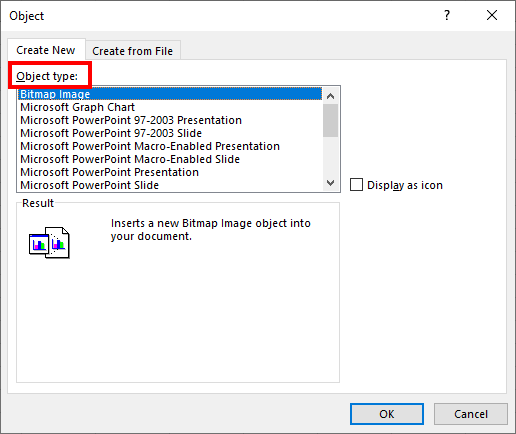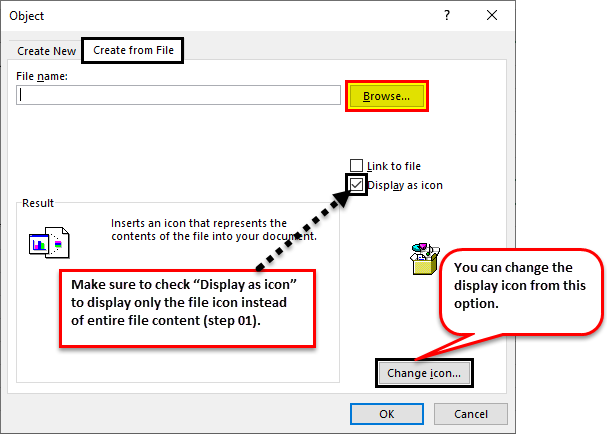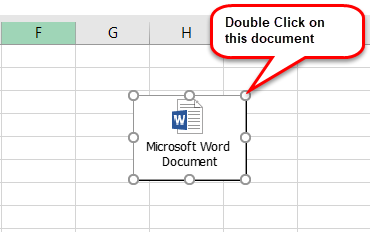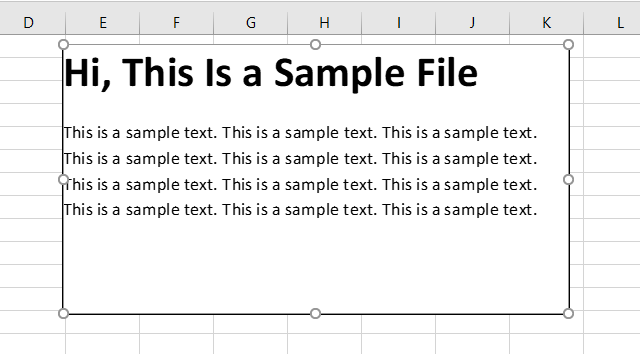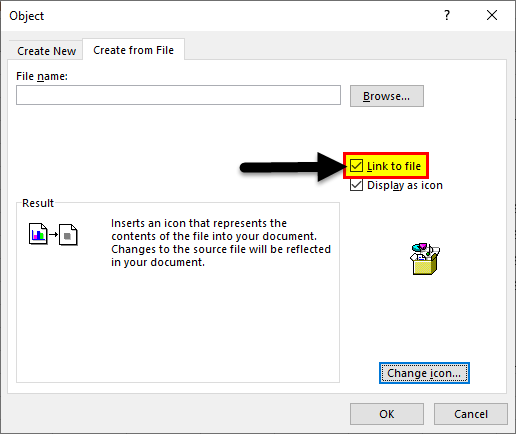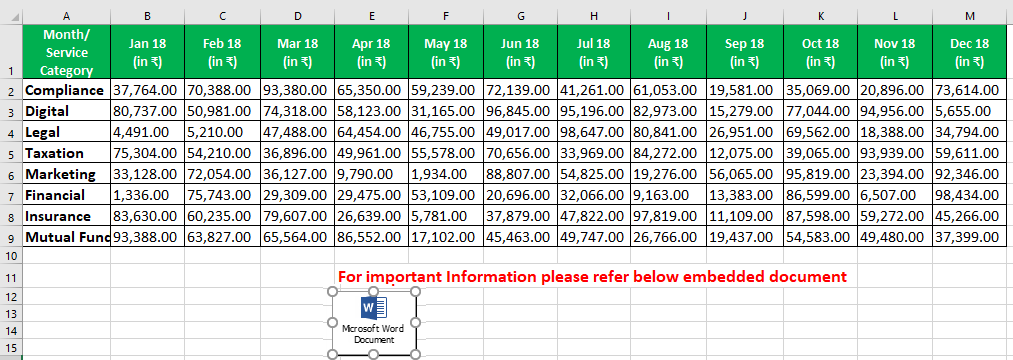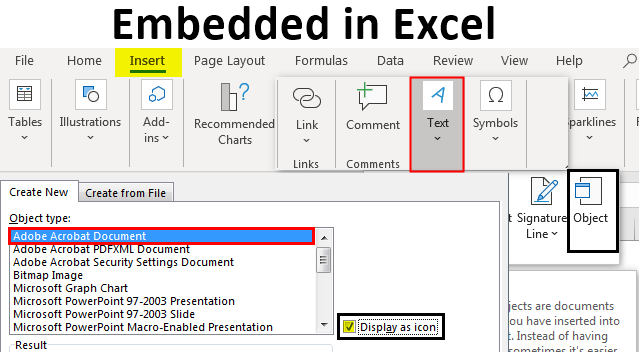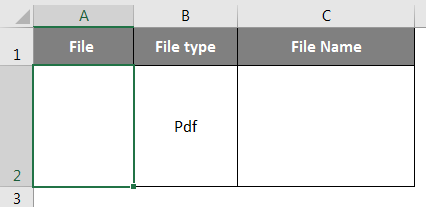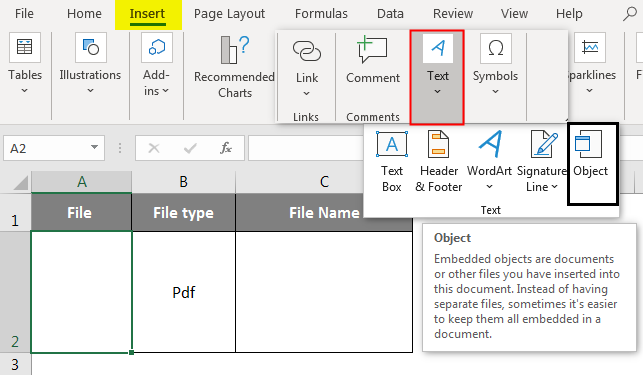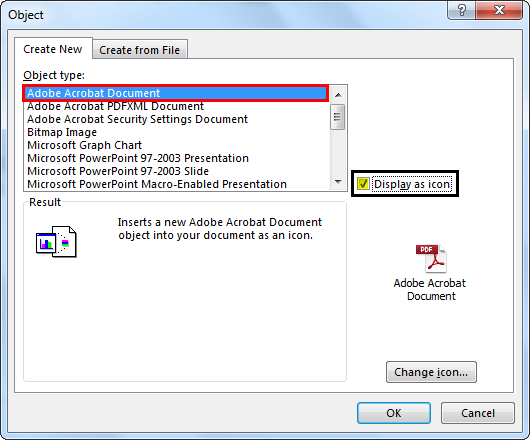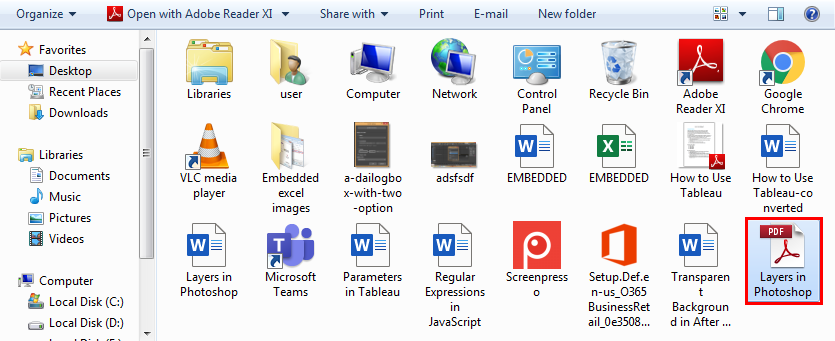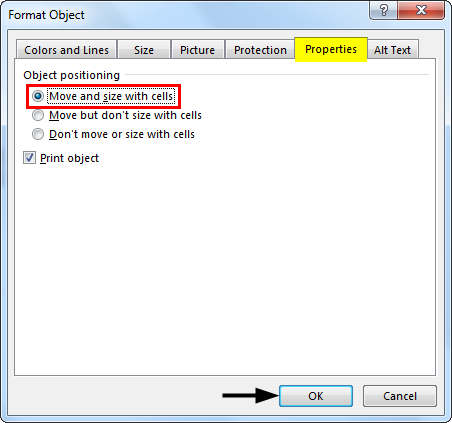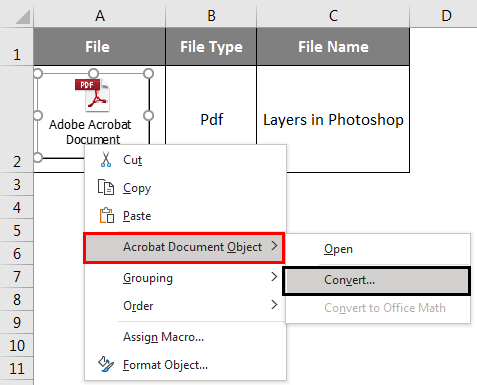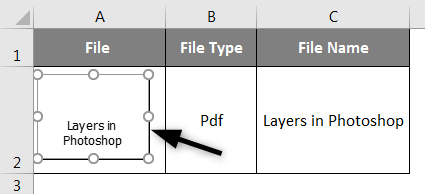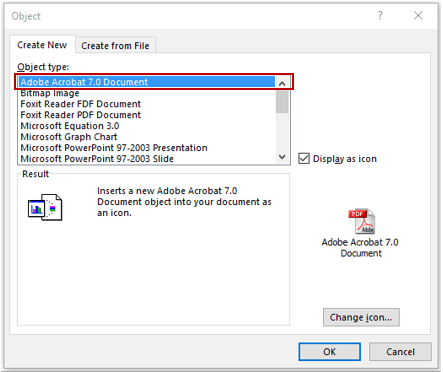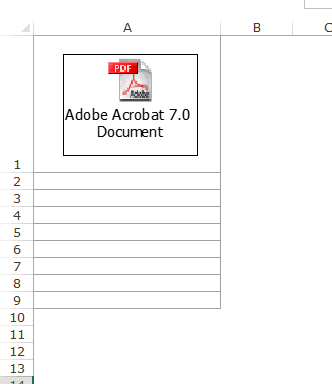You can use Object Linking and Embedding (OLE) to include content from other programs, such as Word or Excel.
OLE is supported by many different programs, and OLE is used to make content that is created in one program available in another program. For example, you can insert an Office Word document in an Office Excel workbook. To see what types of content that you can insert, click Object in the Text group on the Insert tab. Only programs that are installed on your computer and that support OLE objects appear in the Object type box.
If you copy information between Excel or any program that supports OLE, such as Word, you can copy the information as either a linked object or an embedded object. The main differences between linked objects and embedded objects are where the data is stored and how the object is updated after you place it in the destination file. Embedded objects are stored in the workbook that they are inserted in, and they are not updated. Linked objects remain as separate files, and they can be updated.
Linked and embedded objects in a document

1. An embedded object has no connection to the source file.
2. A linked object is linked to the source file.
3. The source file updates the linked object.
When to use linked objects
If you want the information in your destination file to be updated when the data in the source file changes, use linked objects.
With a linked object, the original information remains stored in the source file. The destination file displays a representation of the linked information but stores only the location of the original data (and the size if the object is an Excel chart object). The source file must remain available on your computer or network to maintain the link to the original data.
The linked information can be updated automatically if you change the original data in the source file. For example, if you select a paragraph in a Word document and then paste the paragraph as a linked object in an Excel workbook, the information can be updated in Excel if you change the information in your Word document.
When to use embedded objects
If you don’t want to update the copied data when it changes in the source file, use an embedded object. The version of the source is embedded entirely in the workbook. If you copy information as an embedded object, the destination file requires more disk space than if you link the information.
When a user opens the file on another computer, he can view the embedded object without having access to the original data. Because an embedded object has no links to the source file, the object is not updated if you change the original data. To change an embedded object, double-click the object to open and edit it in the source program. The source program (or another program capable of editing the object) must be installed on your computer.
Changing the way that an OLE object is displayed
You can display a linked object or embedded object in a workbook exactly as it appears in the source program or as an icon. If the workbook will be viewed online, and you don’t intend to print the workbook, you can display the object as an icon. This minimizes the amount of display space that the object occupies. Viewers who want to display the information can double-click the icon.
Embed an object in a worksheet
-
Click inside the cell of the spreadsheet where you want to insert the object.
-
On the Insert tab, in the Text group, click Object
.
-
In the Object dialog box, click the Create from File tab.
-
Click Browse, and select the file you want to insert.
-
If you want to insert an icon into the spreadsheet instead of show the contents of the file, select the Display as icon check box. If you don’t select any check boxes, Excel shows the first page of the file. In both cases, the complete file opens with a double click. Click OK.
Note: After you add the icon or file, you can drag and drop it anywhere on the worksheet. You can also resize the icon or file by using the resizing handles. To find the handles, click the file or icon one time.
Insert a link to a file
You might want to just add a link to the object rather than fully embedding it. You can do that if your workbook and the object you want to add are both stored on a SharePoint site, a shared network drive, or a similar location, and if the location of the files will remain the same. This is handy if the linked object undergoes changes because the link always opens the most up-to-date document.
Note: If you move the linked file to another location, the link won’t work anymore.
-
Click inside the cell of the spreadsheet where you want to insert the object.
-
On the Insert tab, in the Text group, click Object
.
-
Click the Create from File tab.
-
Click Browse, and then select the file you want to link.
-
Select the Link to file check box, and click OK.
Create a new object from inside Excel
You can create an entirely new object based on another program without leaving your workbook. For example, if you want to add a more detailed explanation to your chart or table, you can create an embedded document, such as a Word or PowerPoint file, in Excel. You can either set your object to be displayed right in a worksheet or add an icon that opens the file.
-
Click inside the cell of the spreadsheet where you want to insert the object.
-
On the Insert tab, in the Text group, click Object
.
-
On the Create New tab, select the type of object you want to insert from the list presented. If you want to insert an icon into the spreadsheet instead of the object itself, select the Display as icon check box.
-
Click OK. Depending on the type of file you are inserting, either a new program window opens or an editing window appears within Excel.
-
Create the new object you want to insert.
When you’re done, if Excel opened a new program window in which you created the object, you can work directly within it.
When you’re done with your work in the window, you can do other tasks without saving the embedded object. When you close the workbook your new objects will be saved automatically.
Note: After you add the object, you can drag and drop it anywhere on your Excel worksheet. You can also resize the object by using the resizing handles. To find the handles, click the object one time.
Embed an object in a worksheet
-
Click inside the cell of the spreadsheet where you want to insert the object.
-
On the Insert tab, in the Text group, click Object.
-
Click the Create from File tab.
-
Click Browse, and select the file you want to insert.
-
If you want to insert an icon into the spreadsheet instead of show the contents of the file, select the Display as icon check box. If you don’t select any check boxes, Excel shows the first page of the file. In both cases, the complete file opens with a double click. Click OK.
Note: After you add the icon or file, you can drag and drop it anywhere on the worksheet. You can also resize the icon or file by using the resizing handles. To find the handles, click the file or icon one time.
Insert a link to a file
You might want to just add a link to the object rather than fully embedding it. You can do that if your workbook and the object you want to add are both stored on a SharePoint site, a shared network drive, or a similar location, and if the location of the files will remain the same. This is handy if the linked object undergoes changes because the link always opens the most up-to-date document.
Note: If you move the linked file to another location, the link won’t work anymore.
-
Click inside the cell of the spreadsheet where you want to insert the object.
-
On the Insert tab, in the Text group, click Object.
-
Click the Create from File tab.
-
Click Browse, and then select the file you want to link.
-
Select the Link to file check box, and click OK.
Create a new object from inside Excel
You can create an entirely new object based on another program without leaving your workbook. For example, if you want to add a more detailed explanation to your chart or table, you can create an embedded document, such as a Word or PowerPoint file, in Excel. You can either set your object to be displayed right in a worksheet or add an icon that opens the file.
-
Click inside the cell of the spreadsheet where you want to insert the object.
-
On the Insert tab, in the Text group, click Object.
-
On the Create New tab, select the type of object you want to insert from the list presented. If you want to insert an icon into the spreadsheet instead of the object itself, select the Display as icon check box.
-
Click OK. Depending on the type of file you are inserting, either a new program window opens or an editing window appears within Excel.
-
Create the new object you want to insert.
When you’re done, if Excel opened a new program window in which you created the object, you can work directly within it.
When you’re done with your work in the window, you can do other tasks without saving the embedded object. When you close the workbook your new objects will be saved automatically.
Note: After you add the object, you can drag and drop it anywhere on your Excel worksheet. You can also resize the object by using the resizing handles. To find the handles, click the object one time.
Link or embed content from another program by using OLE
You can link or embed all or part of the content from another program.
Create a link to content from another program
-
Click in the worksheet where you want to place the linked object.
-
On the Insert tab, in the Text group, click Object.
-
Click the Create from File tab.
-
In the File name box, type the name of the file, or click Browse to select from a list.
-
Select the Link to file check box.
-
Do one of the following:
-
To display the content, clear the Display as icon check box.
-
To display an icon, select the Display as icon check box. Optionally, to change the default icon image or label, click Change Icon, and then click the icon that you want from the Icon list, or type a label in the Caption box.
Note: You cannot use the Object command to insert graphics and certain types of files. To insert a graphic or file, on the Insert tab, in the Illustrations group, click Picture.
-
Embed content from another program
-
Click in the worksheet where you want to place the embedded object.
-
On the Insert tab, in the Text group, click Object.
-
If the document does not already exist, click the Create New tab. In the Object type box, click the type of object that you want to create.
If the document already exists, click the Create from File tab. In the File name box, type the name of the file, or click Browse to select from a list.
-
Clear the Link to file check box.
-
Do one of the following:
-
To display the content, clear the Display as icon check box.
-
To display an icon, select the Display as icon check box. To change the default icon image or label, click Change Icon, and then click the icon that you want from the Icon list, or type a label in the Caption box.
-
Link or embed partial content from another program
-
From a program other than Excel, select the information that you want to copy as a linked or embedded object.
-
On the Home tab, in the Clipboard group, click Copy.
-
Switch to the worksheet that you want to place the information in, and then click where you want the information to appear.
-
On the Home tab, in the Clipboard group, click the arrow below Paste, and then click Paste Special.
-
Do one of the following:
-
To paste the information as a linked object, click Paste link.
-
To paste the information as an embedded object, click Paste. In the As box, click the entry with the word «object» in its name. For example, if you copied the information from a Word document, click Microsoft Word Document Object.
-
Change the way that an OLE object is displayed
-
Right-click the icon or object, point to object typeObject (for example, Document Object), and then click Convert.
-
Do one of the following:
-
To display the content, clear the Display as icon check box.
-
To display an icon, select the Display as icon check box. Optionally, you can change the default icon image or label. To do that, click Change Icon, and then click the icon that you want from the Icon list, or type a label in the Caption box.
-
Control updates to linked objects
You can set links to other programs to be updated in the following ways: automatically, when you open the destination file; manually, when you want to see the previous data before updating with the new data from the source file; or when you specifically request the update, regardless of whether automatic or manual updating is turned on.
Set a link to another program to be updated manually
-
On the Data tab, in the Connections group, click Edit Links.
Note: The Edit Links command is unavailable if your file does not contain links to other files.
-
In the Source list, click the linked object that you want to update. An A in the Update column means that the link is automatic, and an M in the Update column means that the link is set to Manual update.
Tip: To select multiple linked objects, hold down CTRL and click each linked object. To select all linked objects, press CTRL+A.
-
To update a linked object only when you click Update Values, click Manual.
Set a link to another program to be updated automatically
-
On the Data tab, in the Connections group, click Edit Links.
Note: The Edit Links command is unavailable if your file does not contain links to other files.
-
In the Source list, click the linked object that you want to update. An A in the Update column means that the link will update automatically, and an M in the Update column means that the link must be updated manually.
Tip: To select multiple linked objects, hold down CTRL and click each linked object. To select all linked objects, press CTRL+A.
-
Click OK.
Issue: I can’t update the automatic links on my worksheet
The Automatic option can be overridden by the Update links to other documents Excel option.
To ensure that automatic links to OLE objects can be automatically updated:
-
Click the Microsoft Office Button
, click Excel Options, and then click the Advanced category.
-
Under When calculating this workbook, make sure that the Update links to other documents check box is selected.
Update a link to another program now
-
On the Data tab, in the Connections group, click Edit Links.
Note: The Edit Links command is unavailable if your file does not contain linked information.
-
In the Source list, click the linked object that you want to update.
Tip: To select multiple linked objects, hold down CTRL and click each linked object. To select all linked objects, press CTRL+A.
-
Click Update Values.
Edit content from an OLE program
While you are in Excel, you can change the content linked or embedded from another program.
Edit a linked object in the source program
-
On the Data tab, in the Connections group, click Edit Links.
Note: The Edit Links command is unavailable if your file does not contain linked information.
-
In the Source file list, click the source for the linked object, and then click Open Source.
-
Make the changes that you want to the linked object.
-
Exit the source program to return to the destination file.
Edit an embedded object in the source program
-
Double-click the embedded object to open it.
-
Make the changes that you want to the object.
-
If you are editing the object in place within the open program, click anywhere outside of the object to return to the destination file.
If you edit the embedded object in the source program in a separate window, exit the source program to return to the destination file.
Note: Double-clicking certain embedded objects, such as video and sound clips, plays the object instead of opening a program. To edit one of these embedded objects, right-click the icon or object, point to object typeObject (for example, Media Clip Object), and then click Edit.
Edit an embedded object in a program other than the source program
-
Select the embedded object that you want to edit.
-
Right-click the icon or object, point to object typeObject (for example, Document Object), and then click Convert.
-
Do one of the following:
-
To convert the embedded object to the type that you specify in the list, click Convert to.
-
To open the embedded object as the type that you specify in the list without changing the embedded object type, click Activate.
-
Select an OLE object by using the keyboard
-
Press CTRL+G to display the Go To dialog box.
-
Click Special, select Objects, and then click OK.
-
Press TAB until the object that you want is selected.
-
Press SHIFT+F10.
-
Point to Object or Chart Object, and then click Edit.
Issue: When I double-click a linked or embedded object, a «cannot edit» message appears
This message appears when the source file or source program can’t be opened.
Make sure that the source program is available If the source program is not installed on your computer, convert the object to the file format of a program that you do have installed.
Ensure that memory is adequate Make sure that you have enough memory to run the source program. Close other programs to free up memory, if necessary.
Close all dialog boxes If the source program is running, make sure that it doesn’t have any open dialog boxes. Switch to the source program, and close any open dialog boxes.
Close the source file If the source file is a linked object, make sure that another user doesn’t have it open.
Ensure that the source file name has not changed If the source file that you want to edit is a linked object, make sure that it has the same name as it did when you created the link and that it has not been moved. Select the linked object, and then click the Edit Links command in the Connections group on the Data tab to see the name of the source file. If the source file has been renamed or moved, use the Change Source button in the Edit Links dialog box to locate the source file and reconnect the link.
Need more help?
You can always ask an expert in the Excel Tech Community or get support in the Answers community.
In Microsoft Excel, the “Object Insert” option allows a user to insert an external object into a worksheet. Embedding generally means inserting an object from another software (Word, PDF, etc.) into an Excel worksheet. This option is useful for direct access to files related to your worksheet data from within your worksheet space. In addition, the inserted object works as a ready information source or reference for a dataset in an Excel worksheet.
Table of contents
- Insert and Embed an Object in Excel
- How to Insert (Embed) an Object in Excel?
- #1 – Insert (Embed) a New Object in Excel
- #2 – Embedding (inserting) an Existing Object in Excel
- #3 – Link to Object vs. Embedded Object
- Why we need Embedded Object in Excel?
- Things to Remember about Inserting Object in Excel
- Recommended Articles
- How to Insert (Embed) an Object in Excel?
How to Insert (Embed) an Object in Excel?
Here, we will discuss how to embed a new object in Excel.
You can download this Embed File Excel Template here – Embed File Excel Template
#1 – Insert (Embed) a New Object in Excel
- We must first select “Text” from the “Insert” tab and then click “Object.”
- Then, select “Create New” to embed a new blank file. Remember, only file types are shown in “Object type” that can be embedded in the Excel worksheet.
- Now, choose a file type to embed. For example, we have selected a “Microsoft Word Document,” now click “OK.”
#2 – Embedding (inserting) an Existing Object in Excel
Step 1: Select “Text” from the “Insert” tab and click “Object.”
Step 2: Select “Create from File” and click “Browse” to embed an existing file into the worksheet. Remember, only file types are shown in “Object Type” that can be embedded in the Excel worksheet.
Step 3: Now click “OK.” The file icon will be displayed on the worksheet.
NOTE: If we do not check the “Display as icon” option, it will show the embedded file’s content instead of the icon. We can double-click on the embedded file icon or content to edit the content of the embedded file.
#3 – Link to Object vs. Embedded Object
When you insert an object into an Excel worksheet, the object becomes part of the Excel file. Therefore, any changes made to the source file do not impact the embedded file. However, we may want to keep the file separate from the Excel file. In that case, we need to check the “Link to file” option.
A linked file is just a link to the source file, which we can edit only by editing the source file. When we double-click the link, the source file will open.
NOTE: If we change the location/ path of the source file, the link to the file in the worksheet will not work.
Why do we need Embedded Objects in Excel?
- When we want to add large comments or notes to a dataset in Excel Worksheet, we can embed a Word or text file instead of writing text in worksheet cells.
- Excel is generally used for data tables/ charts. Suppose we want to use big text bodies to explain the data tables in a worksheet. In that case, we can create a separate embedded file within the worksheet instead of creating a particular file or writing a large amount of text in an Excel worksheet.
- Embedded files keep the worksheet presentation limited to required data only. We can keep any additional comments, notes, or information within the embedded file, allowing users to focus on the key information. Other data can be seen only by accessing the embedded file.
4. Embedded files are the preferred option compared to the link to file option when we need to send the worksheet to someone working on a different computer/ laptop since the link to file will only work if the source file is saved on the same device as the worksheet itself since embedded files are saved within the Excel file.
Things to Remember about Inserting Object in Excel
- We can only embed certain file types into an Excel worksheet. We can see the list of file types accepted by going to “Insert” > “Text” > “Object” > “Create New” > “Object type.”
- Select the “Display as icon” checkbox to display only the embedded file’s icon. Otherwise, it will show the file content in the worksheet, which takes more space and is not recommended for presentation purposes.
NOTE: If we intend to print the worksheet, then it is recommended to display the content of the embedded file as it will not publish the embedded file’s content if the only icon is displayed.
- As soon as we insert an object in Excel, its connection to the source file is lost, so make sure to make all required changes to the original file before embedding it. However, you can also update the embedded file’s content by double-clicking the file icon or embedded content.
- When sending an embedded file to someone else, ensure that the recipient’s computer/ laptop has the required software installed, supporting the embedded file type to view or change its content.
- Inserting an object in Excel increases the source Excel file size. If we do not want to make the Excel file heavy, we can use the “Link to file” option. However, the “Link to file” option only works if we use the same device where the linked source file is stored, and the source file’s location/ path is not changed.
Recommended Articles
This article is a guide to Embed and Insert Object in Excel. We discuss inserting an object in an Excel worksheet, practical examples, and a downloadable excel template. You may learn more about Excel from the following articles:-
- VBA Insert RowTo insert rows we use worksheet method with the insert command to insert a row, we also provide a row reference where we want to insert another row similar to the columns.read more
- Insert Button in ExcelButtons in excel are single-click commands inserted to perform specific tasks. Buttons are used in macros and can be inserted by enabling the developer’s tab; in the insert form, we can find a button to insert and draw it to the worksheet.read more
- Insert Comment in ExcelIn Excel, Insert Comment is a feature used to share tips or details with different users working within the same spreadsheet. You can either right-click on the required cell, click on “Insert Comment” & type the comment, use the shortcut key, i.e., Shift+F2, or click on the Review Tab & select “New Comment”. read more
- Insert Hyperlinks in ExcelTo insert a hyperlink, right-click on the cell, click on hyperlink, and then choose the last option, which will open a wizard box to insert a hyperlink. Then, in the field for an address, type the hyperlink’s URL.read more
- Themes in ExcelThemes in Excel are used to format the entire document or workbook; we can use the themes provided by Excel or customize it to our likingread more
Reader Interactions
Insert a link to a file
- Click inside the cell of the spreadsheet where you want to insert the object.
- On the Insert tab, in the Text group, click Object.
- Click the Create from File tab.
- Click Browse, and then select the file you want to link.
- Select the Link to file check box, and click OK.
Also to know is, what is embedded object in Excel?
Introduction to Embedded in Excel. Object Linking and Embedding (OLE) is a process or technique used to insert data from one Programme into another. OLE is used to create content that is created in one program available in another program.
Beside above, what is the difference between object linking and embedding? You can add objects such as a file, an image or an audio file to a Word document, an Excel spreadsheet, an HTML document by linking or embedding. The main difference between linking and embedding is where the data are stored and how they are updated after they where linked or embedded.
One may also ask, how do I rename an embedded object in Excel?
Modify The Name Of The Previously Inserted Embedded File
- Right-click on the embedded file which you inserted in your document.
- From there select the option “Microsoft Document Object”.
- From there select ‘Convert’.
- Now click on ‘Change icon’.
- Select the icon and change the caption name there.
How do you link an embedded object in Word?
To link or embed an object that’s already been created:
- In the Object dialog box, select the Create from File tab, and then click Browse to find the file you want to insert.
- To link to the source file, rather than embedding it into your Word document or email message, select Link to file.
Содержание
- Insert an object in your Excel spreadsheet
- Insert an object in your Excel spreadsheet
- Embedded in Excel
- Introduction to Embedded in Excel
- When & Where to Use Embedded Objects?
- How to Enable or Add Embedded Objects in Excel?
- How to Insert the Embedded PDF File Object?
- Difference between Linked and Embedded Objects
- Things to Remember About Embedded Objects in Excel
- Recommended Articles
- How to Embed a PDF File in an Excel Worksheet
- How to Embed a PDF File in an Excel Worksheet
- Fix the Embedded PDF File to a Cell
- Renaming the Embedded PDF File
Insert an object in your Excel spreadsheet
You can use Object Linking and Embedding (OLE) to include content from other programs, such as Word or Excel.
OLE is supported by many different programs, and OLE is used to make content that is created in one program available in another program. For example, you can insert an Office Word document in an Office Excel workbook. To see what types of content that you can insert, click Object in the Text group on the Insert tab. Only programs that are installed on your computer and that support OLE objects appear in the Object type box.
If you copy information between Excel or any program that supports OLE, such as Word, you can copy the information as either a linked object or an embedded object. The main differences between linked objects and embedded objects are where the data is stored and how the object is updated after you place it in the destination file. Embedded objects are stored in the workbook that they are inserted in, and they are not updated. Linked objects remain as separate files, and they can be updated.
Linked and embedded objects in a document
1. An embedded object has no connection to the source file.
2. A linked object is linked to the source file.
3. The source file updates the linked object.
When to use linked objects
If you want the information in your destination file to be updated when the data in the source file changes, use linked objects.
With a linked object, the original information remains stored in the source file. The destination file displays a representation of the linked information but stores only the location of the original data (and the size if the object is an Excel chart object). The source file must remain available on your computer or network to maintain the link to the original data.
The linked information can be updated automatically if you change the original data in the source file. For example, if you select a paragraph in a Word document and then paste the paragraph as a linked object in an Excel workbook, the information can be updated in Excel if you change the information in your Word document.
When to use embedded objects
If you don’t want to update the copied data when it changes in the source file, use an embedded object. The version of the source is embedded entirely in the workbook. If you copy information as an embedded object, the destination file requires more disk space than if you link the information.
When a user opens the file on another computer, he can view the embedded object without having access to the original data. Because an embedded object has no links to the source file, the object is not updated if you change the original data. To change an embedded object, double-click the object to open and edit it in the source program. The source program (or another program capable of editing the object) must be installed on your computer.
Changing the way that an OLE object is displayed
You can display a linked object or embedded object in a workbook exactly as it appears in the source program or as an icon. If the workbook will be viewed online, and you don’t intend to print the workbook, you can display the object as an icon. This minimizes the amount of display space that the object occupies. Viewers who want to display the information can double-click the icon.
Источник
Insert an object in your Excel spreadsheet
You can use Object Linking and Embedding (OLE) to include content from other programs, such as Word or Excel.
OLE is supported by many different programs, and OLE is used to make content that is created in one program available in another program. For example, you can insert an Office Word document in an Office Excel workbook. To see what types of content that you can insert, click Object in the Text group on the Insert tab. Only programs that are installed on your computer and that support OLE objects appear in the Object type box.
If you copy information between Excel or any program that supports OLE, such as Word, you can copy the information as either a linked object or an embedded object. The main differences between linked objects and embedded objects are where the data is stored and how the object is updated after you place it in the destination file. Embedded objects are stored in the workbook that they are inserted in, and they are not updated. Linked objects remain as separate files, and they can be updated.
Linked and embedded objects in a document
1. An embedded object has no connection to the source file.
2. A linked object is linked to the source file.
3. The source file updates the linked object.
When to use linked objects
If you want the information in your destination file to be updated when the data in the source file changes, use linked objects.
With a linked object, the original information remains stored in the source file. The destination file displays a representation of the linked information but stores only the location of the original data (and the size if the object is an Excel chart object). The source file must remain available on your computer or network to maintain the link to the original data.
The linked information can be updated automatically if you change the original data in the source file. For example, if you select a paragraph in a Word document and then paste the paragraph as a linked object in an Excel workbook, the information can be updated in Excel if you change the information in your Word document.
When to use embedded objects
If you don’t want to update the copied data when it changes in the source file, use an embedded object. The version of the source is embedded entirely in the workbook. If you copy information as an embedded object, the destination file requires more disk space than if you link the information.
When a user opens the file on another computer, he can view the embedded object without having access to the original data. Because an embedded object has no links to the source file, the object is not updated if you change the original data. To change an embedded object, double-click the object to open and edit it in the source program. The source program (or another program capable of editing the object) must be installed on your computer.
Changing the way that an OLE object is displayed
You can display a linked object or embedded object in a workbook exactly as it appears in the source program or as an icon. If the workbook will be viewed online, and you don’t intend to print the workbook, you can display the object as an icon. This minimizes the amount of display space that the object occupies. Viewers who want to display the information can double-click the icon.
Источник
Embedded in Excel
Embedded in Excel (Table of Contents)
Introduction to Embedded in Excel
With the help of Embed in Excel, we can link a table of excel with the data in a Word file. If there are any changes made in the Excel table, it will automatically be applied to the Word file only if the files are in the same location or folder. To use Embed in Excel, go to Insert menu ribbon and select Object under the Text section. Now browse and select the file which we want to link with Excel. Once we do that, we will be able to see the changes getting reflected in the Word file if we do anything in the Excel file.
Excel functions, formula, charts, formatting creating excel dashboard & others
It is a technique to insert data files from one Programme into another. It also provides an option to insert outside media for design customization. When you click on the Insert tab in the toolbar, under the Text group, select or click on Object.
When & Where to Use Embedded Objects?
If you don’t want to update the copied data when it changes in the source file, you can use an embedded object. Below mentioned objects can be added. i.e. Images, clipart, pictures, audio file, Word document, PDF, PPT, Excel spreadsheet & HTML document. The embedded object plays an important role during a meeting or to share more comprehensive information when you send the spreadsheet to a co-worker.
How to Enable or Add Embedded Objects in Excel?
Let’s check out the various file types or an embedded object that can be added in excel.
In the below-mentioned example, I have an excel file named as “Embedded”, in that I have selected the cell “A2”, where I need to insert a pdf file as an embedded object. I need to select a cell “A6” in a spreadsheet where I want to insert the object & and increase the row size, i.e. row height & column width, for better visibility.
Once you select cell “A2” under the excel toolbar, select the “Insert” tab; in that, click “Object” in the Text group to open the Object dialog box.
Now the object window will appear. In that object window, you will see two options.
Create New – It will create a new file and embed it in the worksheet.
Create from File – It will embed an existing file in the worksheet.
You need to select the “Create from File” tab. As we add a PDF file, you need to select “Adobe Acrobat Document” under the object type. Check or tick the box of the display as Icon.
The file name window appears where you need to locate the file, which you want to attach. Click the file to select it and click the “Insert” button.
Select the PDF file that you want to embed and click on Open (PDF File Name: Layers in Photoshop); this step will insert a PDF file in the worksheet. As soon as the PDF is inserted into the worksheet, the PDF also opens by default. You can close the PDF file and continue to work with Excel.
PDF appears in cell “A2” as an “Embedded” object (just like shapes or charts), and you can resize it based on your choice and place it anywhere in the worksheet.
Now, at last, if you double click on the pdf object, that PDF file will get opened. Simultaneously you can insert multiple PDFs or other files by following the above-mentioned steps.
How to Insert the Embedded PDF File Object?
Let’s look at how to insert an embedded PDF file object or icon in a cell.
AN embedded PDF file in Excel is inserted as an object sometimes, sits above the worksheet cells. The position of the object remains stagnant when you increase the column width or if you move a cursor of a mouse down to other cells. To fix this, right-click on the PDF object icon and select Format Object. (If you have multiple other PDF or word files embedded, you can simultaneously select all and then right-click and select the Format Object option.).
Once you select the Format Object option, the Format Object dialog box appears; in that, select Properties tab and under the object positioning, select the option ‘Move and size with cells.
When you embed a PDF file in Excel, it gets a generic name such as “Adobe Acrobat Document”. You have an option to change the PDF name for a better appearance. The below-mentioned steps can change the name of the PDF object:
Select the PDF object, right-click on the PDF object and select the Convert to option in the Acrobat Document Object.
In the Convert dialog box, click on the Change Icon button, change icon button dialog box appears; under that browse file type, select that PDF file which is represented as an object.
Change the caption to the name of your choice for the embedded PDF document, i.e. I have changed to Layers in Photoshop. Now, click OK; this will automatically change the name of the embedded PDF file.
Change Icon feature is also available to change the appearance of an icon OR object that represents the embedded file. There is a various list of options that appears in the ICON dropdown under the Change Icon window.
Difference between Linked and Embedded Objects
- Linked objects will be present as separate files, and they can be updated, linked object is linked to the source file, The source file updates the linked object.
- Whereas Embedded objects are stored in the workbook where they are inserted in, they cannot update.
Things to Remember About Embedded Objects in Excel
- Embedded files in excel can also be displayed as links or icons.
- With the help of go to a special feature in Excel, you can find & select all the embedded object in a worksheet.
- Select the specified worksheet where you need to find out all embedded objects.
Recommended Articles
This is a guide to Embedded in Excel. Here we discuss How to insert Embedded Objects in Excel along with practical examples and a downloadable excel template. You can also go through our other suggested articles –
Источник
How to Embed a PDF File in an Excel Worksheet
Watch Video – How to Embed a PDF File in Excel
Sometimes you may have a need to embed a PDF file within the Excel workbook. This could be the case when you are creating a catalog and want to embed product specific PDFs.
In this tutorial, you’ll learn how to insert a PDF file in an Excel Worksheet.
This Tutorial Covers:
How to Embed a PDF File in an Excel Worksheet
Here are the steps to embed a PDF File in Excel:
- Go to Insert tab and click on the Object icon in the Text group. This will open the Object dialog box.
- In the Object dialog box, select the ‘Create New’ tab and the select ‘Adobe Acrobat Document’ from the list. Note that you need to have Adobe Reader installed on your system for Adobe object to appear in the list.
- Check the option – ‘Display as icon’.
- Click OK.
- Select the PDF file that you want to embed and click on Open.
These steps would insert a PDF file in the worksheet.
As soon as the PDF is inserted in the worksheet, it also gets opened by default. You can close the PDF file and continue to work with Excel.
The PDF icon inserted using the above steps is an object (just like charts or shapes) and you can resize it and place it anywhere in the worksheet.
To insert multiple PDFs, follow the same steps (as shown above).
Fix the Embedded PDF File to a Cell
When you embed a PDF file in Excel, it is inserted as an object that sits above the worksheet cells. The position of the icon would not change if you change the cells below it.
For example, when you place the icon within a cell, it would not move with the cells and would not get filtered, sorted, or hidden with the cells.
As shown below, if you hide the cell that has the PDF file, it doesn’t hide the PDF.
To make sure it sticks to the cell:
Now when you filter or sort/filter the cells, or hide the rows, the PDF object will do the same.
Renaming the Embedded PDF File
When you embed a PDF file in Excel, it gets a generic name such as “Adobe Acrobat Document”.
You can change this name by following the below steps:
This will change the name of the embedded PDF file.
Want to convert PDF files to Excel? Check out my tutorial where I show the exact steps to convert PDF files to Excel.
You May Also Like the Following Excel Tutorials:
Источник
Embed an object in a worksheet
- Click inside the cell of the spreadsheet where you want to insert the object.
- On the Insert tab, in the Text group, click Object .
- In the Object dialog box, click the Create from File tab.
- Click Browse, and select the file you want to insert.
Contents
- 1 How do I embed in Excel 2016?
- 2 Can you embed an attachment in Excel?
- 3 How do I enable embed in Excel?
- 4 What is embedded data in Excel?
- 5 How do I find an embedded object in Excel?
- 6 How do I embed an Excel file in Word?
- 7 How do I insert a file path in Excel?
- 8 How do you embed a PDF in Excel?
- 9 How do I open an embedded PDF in Excel?
- 10 How do I use iframe in Excel?
- 11 How do I embed an Excel spreadsheet in HTML?
- 12 Can you embed an Excel sheet in SharePoint?
- 13 What is linking and embedding in Excel?
- 14 What’s the difference between embedding and linking?
- 15 Where does an embedded object reside?
- 16 What is the difference between embedding and linking an object in a document?
- 17 What is the difference between object linking and object embedding?
- 18 What is an embedded file?
- 19 How do you turn an Excel File into a link?
- 20 How do I insert a file path?
How do I embed in Excel 2016?
Embed an Excel Object
- Click the Insert tab > Text Group > Object menu and choose Object.
- From the popup window, click the Create from File tab.
- Click the Browse button and navigate to the folder where your Excel spreadsheet and chart are located.
- Double click the Excel file to open it and click OK.
Can you embed an attachment in Excel?
Select the Insert tab then click Object in the text group to open the Object dialog box. Click the Create New tab open a fresh file. Choose the type of object you want to attach from the Object Type box.Close the new program window or click back on the Excel window to attach the new file.
How do I enable embed in Excel?
In OneDrive, right-click the workbook, and then click Embed. Click Generate, and then click Customize how this embedded workbook will appear to others. In the What to show box, click what you want to show in your blog. Show the entire workbook, or show a chart, a named range, PivotTable, or table.
What is embedded data in Excel?
When data is embedded in a presentation or document it allows the data in the presentation to be updated automatically when the data is updated in the source spreadsheet.
How do I find an embedded object in Excel?
You can find and select all embedded objects in a worksheet quickly by the Go To Special feature in Excel. Please do as follows: 1. Click to open the specified worksheet you will find all embedded objects, press F5 key to open the Go To dialog box, and then click the Special button.
How do I embed an Excel file in Word?
Embed an Excel Worksheet as an Object
- Open the Word document.
- Go to the Insert tab.
- Select Object > Object.
- In the Object dialog box, select the Create from File tab.
- Select Browse, then choose the Excel worksheet that contains the data you want to embed.
- Select OK.
- The Excel worksheet is embedded in the Word document.
How do I insert a file path in Excel?
In the Excel Options dialog box: Click Quick Access Toolbar option; Then choose All Commands from the Choose commands from drop down list; And select Document Location, then click Add > > button, the Document Location has been added to the right pane.
How do you embed a PDF in Excel?
Here are the steps to embed a PDF File in Excel:
- Go to Insert tab and click on the Object icon in the Text group.
- In the Object dialog box, select the ‘Create New’ tab and the select ‘Adobe Acrobat Document’ from the list.
- Check the option – ‘Display as icon’.
- Click OK.
How do I open an embedded PDF in Excel?
Open PDF in Excel with Embedded Object
- Open Excel. Open your target excel file first, then click the “Insert” > “Object” button.
- Insert PDF. Select the “Create from File” tab, then click the “Browse” button to select your target PDF file. And you can select the option of “Display as an Icon” in the excel file.
How do I use iframe in Excel?
Combine the Code Strings
In a cell below the variable entry section, a formula creates the IFRAME code: It uses the & operator, to combine text strings. The CHAR function uses 34 as its argument, to create double quote marks. The IF formulas return a variable based on Yes or No selections.
How do I embed an Excel spreadsheet in HTML?
Embed Excel Sheets in Web Pages
Go to office.live.com and create new blank workbook. Enter the tabular data inside the Excel sheet and then choose File -> Share -> Embed -> Generate HTML. Excel, unlike Google Docs, allows you to embed a select range of cells and not the entire spreadsheet.
Can you embed an Excel sheet in SharePoint?
Display excel sheet in SharePoint online using Embed Code
The embed code web part is available in modern experience in SharePoint. So we can use the embed code web part to embed excel spreadsheet in sharepoint online modern sites as well as in SharePoint server 2019 modern site.
What is linking and embedding in Excel?
Object Linking and Embedding (or OLE for short) is a technique used to insert data from one programme into another. We’ll create a simple spreadsheet to illustrate the process, and place it in to Word document. When the Excel spreadsheet is updated, you’ll see the Word version update itself as well.
What’s the difference between embedding and linking?
The main difference between linking and embedding is where the data are stored and how they are updated after they where linked or embedded.Your file embeds a source file: the data are now stored in your file — without a connection to the original source file.
Where does an embedded object reside?
An embedded object is physically stored in the compound document, along with all the information needed to manage the object. In other words, the embedded object is actually a part of the compound document in which it resides.
What is the difference between embedding and linking an object in a document?
When an object is linked, information can be updated if the source file is modified.When you embed an Excel object, information in the Word file doesn’t change if you modify the source Excel file. Embedded objects become part of the Word file and, after they are inserted, they are no longer part of the source file.
What is the difference between object linking and object embedding?
Understand the differences between linked objects and embedded objects. The main differences between linked objects and embedded objects are where the data is stored and how you update the data after you place it in the Word file.If you embed the worksheet in the report, your report contains a static copy of the data.
What is an embedded file?
When designing a Web page, an embedded file refers to any type of multimedia file that you might insert, or embed into the Web page. This includes files like graphics and sound files.
How do you turn an Excel File into a link?
Just select the cell where you want to insert a link and do one of the following:
- On the Insert tab, in the Links group, click the Hyperlink or Link button, depending on your Excel version.
- Right click the cell, and select Hyperlink… (Link in recent versions) from the context menu.
- Press the Ctrl + K shortcut.
How do I insert a file path?
From the “Text” group, click [Quick Parts] > Select “Field…” Under “Field names,” select “FileName.” In the “Field properties” section, select a format. In the “Field options” section, check “Add path to filename.” The file name will now appear in the header or footer.

 .
.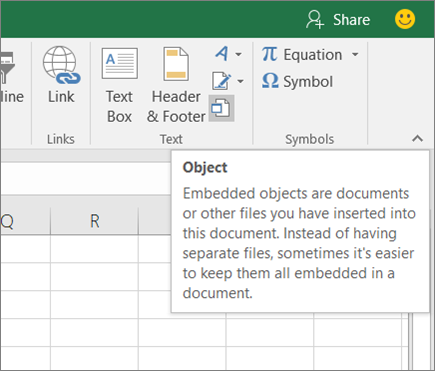


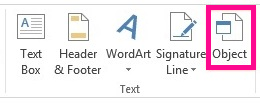
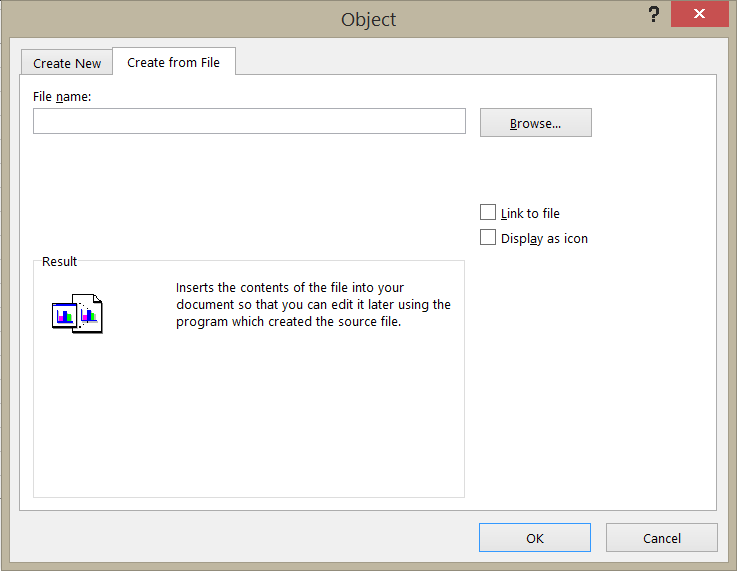
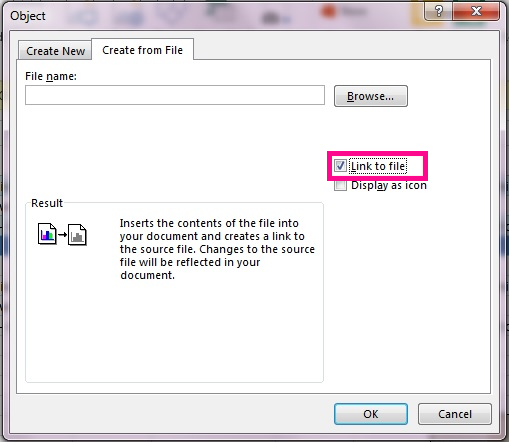
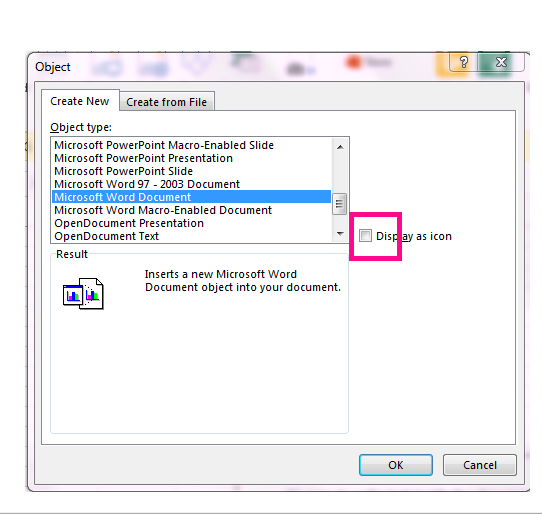



 , click Excel Options, and then click the Advanced category.
, click Excel Options, and then click the Advanced category.
